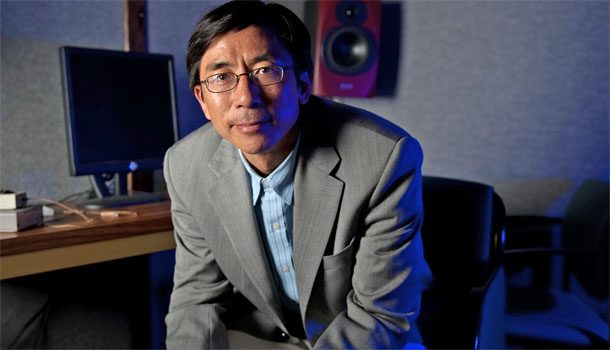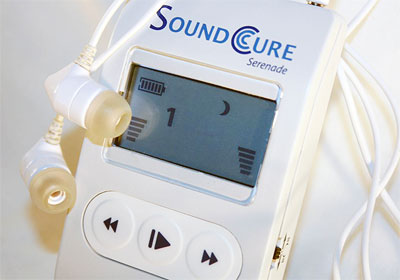
Quieting the ringing in the ears
Tuesday 26 June 2012
A UC Irvine bioengineer, with help from a suffering patient, developed an MP3 player-like device to ease, or even silence, the debilitating noise that afflicts people with tinnitus.
Tinnitus is a condition commonly known as “ringing in the ears.” But for people who suffer from severe tinnitus, that description doesn’t capture how disturbing the experience can be. Tinnitus can sound like ringing, but it can also be a roaring, clicking, or a hissing noise. It can be loud or soft, constant or intermittent, and it afflicts many people with hearing loss.
More than 50 million people in the U.S. suffer from the condition, according to the American Tinnitus Association. Of these, 12 million have it severe enough to seek medical help and 2 million are so debilitated by the condition that they can’t function normally on a day-to-day basis.
Now, people suffering from tinnitus have a new therapeutic tool based on research at UC Irvine. An MP3 player-like device, called the “Serenade Tinnitus Treatment System,” officially debuted in March. It plays specially developed tones that can be customized to suppress a patient’s tinnitus. Unlike current therapies, Serenade doesn’t just drown out the tinnitus with a louder sound, but actively reduces it.

The treatment system grew out of a research project headed by Fan-Gang Zeng (in photo at top of page), a bioengineer and director of the Hearing and Speech Lab at UC Irvine. In 2006, a patient, Michael (not his real name), came to Zeng for help with his cochlear implant.
Michael, a musician and audio engineer in the San Francisco Bay Area, had suddenly and mysteriously lost his hearing in one ear. “I showed up for work one day, and within minutes my hearing shut down on my right side,” he said.
What was worse, that ear immediately developed tinnitus. “It was nothing but loud squealing noises,” he said.
Michael saw a number of specialists and tried all kinds of traditional and alternative therapies, but nothing got rid of the squealing. As a last resort, he decided to get a cochlear implant, a device usually indicated only for people who are deaf in both ears. But evidence has shown that the implants sometimes help relieve tinnitus connected to hearing loss. Unfortunately, the implant didn’t quiet his tinnitus, so his surgeon, Nikolas Blevins of Stanford University, referred Michael to Zeng, an expert in cochlear implants.
Michael met with Zeng, who decided to try to deliver sounds through the implant that might relieve the loud squealing. “I didn't have any research experience in tinnitus at that time,” Zeng said. “We said, ‘Let’s give it a try.’ That's how we got started.”
Soon, Michael became not only a patient but a key collaborator in a research project. “Normally, everyone in this country who's been implanted with a cochlear implant has been completely deaf,” Michael said. “Me, I can compare what goes through the cochlear implant to a perfectly normal hearing ear and tell you what it sounds like. Not to mention having an audio and music background, I can speak in their language and be able to communicate in that way.”
Michael would spend a week in Zeng’s lab every month, flying back and forth from the Bay Area to Irvine. The researchers didn’t know what they were looking for, so they tried all kinds of sounds in a systematic manner. “We tried things from low to high frequencies, white noise, all kinds of frequencies to mask tinnitus. We tried all kinds of things. It took us a long, long time to figure something out,” Zeng said.
One day, Zeng and his colleagues played a low-frequency tone to Michael and asked him how loud it sounded. It was in normal speaking range, Michael said, but the big surprise was that he couldn’t hear his tinnitus at all. “We all just looked at each other,” he said. “I listened and listened, and I tried to hear it, and I said 'I can't pick it out.' We all looked at each other and went, ‘Wow!’”
That initial discovery eventually led to a research project, funded by the American Tinnitus Association. Out of nearly 100 volunteers, only 20 finished the protocol. "It's a very grueling experience for the patient,” Zeng said. “We didn't know which sound works and which one doesn’t, so we just tried them all.”
The researchers tested 17 types of sounds in a range of frequencies, including sounds currently used as tinnitus therapies. “We were surprised that the white noise that clinicians have used most widely and for the longest time proved to be the least effective,” Zeng said.
Instead, they found that sound waves with their amplitude modulated — similar to the frequencies on an AM radio — worked to suppress tinnitus in 60 percent of the volunteers. The team published its results on April 23, 2012, in the Journal of the Association of Research in Otolaryngology.
Zeng said these patterned sounds might be serving to stimulate the brain’s auditory cortex. A steady sound, like the white noise of an empty radio frequency, might stimulate the brain at first, but then the brain gets used to it.
“If you have these modulated sounds, then the brain will continue to respond to it,” Zeng hypothesized. “In tinnitus, you hear something when nothing is there, so there's some activity in the brain. Maybe these modulated sounds will disrupt abnormal activities, which is the basis of your tinnitus."
"It's a step forward but far away from a true cure,” Zeng said.
To bring the research to a wider group of patients, a venture capital firm called Allied Minds licensed the technology and formed the San Jose, Calif., company SoundCure to commercialize it. In August 2011, SoundCure received clearance from the U.S. Food and Drug Administration for the Serenade system, a handheld device that plays the modulated sounds — called “S-Tones” — customized for each tinnitus patient. SoundCure formally launched the product at the American Academy of Audiology Meeting held in Boston in March 2012.
SoundCure provides audiologists with software to test patients and to create sounds that are programmed onto the device, said company CEO Bill Perry. First, the audiologist identifies and tries to match the perceived pitch of the patient’s tinnitus and then modulates the amplitude of the sound wave. “Studies suggest it’s that modulation plus the frequency pitch match that creates brain activity to help reduce a patient's perception of their tinnitus,” Perry said. The patient can listen to the S-Tones through a pair of small earphones whenever he or she needs relief.
The Serenade device can play four different tracks of sound, two of which are the S-Tones developed at UC Irvine. The other two tracks contain more traditional sound therapies. “The goal was to give the patient and the audiologist a complete sound therapy tool,” Perry says. Many patients are already using the device and report relief from the S-Tones where other remedies have failed.
What’s more, this gives researchers a way to obtain insight into tinnitus itself. The tones provide a non-invasive way to test and evaluate a patient’s tinnitus. "It's not just a guessing game anymore,” Zeng said. In the future, it might be possible to diagnose and characterize a person’s tinnitus and find better ways to treat it.
Despite the integral part he played in the research, Michael’s tinnitus still bothers him. “I never have quiet,” he said. “It’s not part of my world anymore. I turn to the device for relief from time to time, but I still live with very loud tinnitus.”
However, he credits Zeng for helping him develop a healthy attitude about it. “In fact, it was his discussions with me that seemed to turn things around for me,” Michael said. “He helped me see the glass half-full. He’s one of my favorite people on the planet.”
Photo of Fan-Gang Zeng by Steve Zylius, UC Irvine Communications